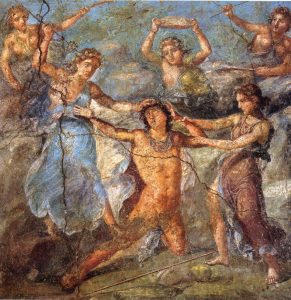[6] λόγου δὲ ἄξια ἐν τῇ πόλει τὰ μὲν λειπόμενα ἔτι τῶν ἀρχαίων ἐστίν, τὰ δὲ πολλὰ αὐτῶν ἐπὶ τῆς ἀκμῆς ἐποιήθη τῆς ὕστερον. ἔστιν οὖν ἐπὶ τῆς ἀγορᾶς— ἐνταῦθα γὰρ πλεῖστά ἐστι τῶν ἱερῶν—Ἄρτεμίς τε ἐπίκλησιν Ἐφεσία καὶ Διονύσου ξόανα ἐπίχρυσα πλὴν τῶν προσώπων: τὰ δὲ πρόσωπα ἀλοιφῇ σφισιν ἐρυθρᾷ κεκόσμηται: Λύσιον δέ, τὸν δὲ Βάκχειον ὀνομάζουσι.
- Map
- Pre Reading
- Post Reading
- Culture Essay
Pausanias’ narrative now jumps from the gates to the city to the middle of the agora, or Roman Forum. The first monuments he mentions, a statue of Artemis and two of Dionysus, have no explicit connection to any particular place in the agora. Both statues allude to ancient cults and the wooden statues (ξόανα) of Dionysus attest to their antiquity. Artemis of Ephesus is depicted with spherical objects across her lower chest, perhaps breasts, bull’s testicles, or gourds, and whose robe features lions, leopards, goats, griffins, and bulls. Thus, her iconography suggests fertility and power over the natural world. She appears to be related to other Anatolian mother goddesses, such as Cybele. Dionysus’ conflict with Pentheus was made most famous by Euripides’ Bacchae.
After reading about monuments in the agora, review Uses of the Article-Post-reading-RoadtoCorinth-Agora

